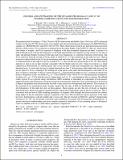CHANDRA AND HST IMAGING OF THE QUASARS PKS B0106+013 AND 3C 345: INVERSE COMPTON X-RAYS AND MAGNETIZED JETS
Author(s)
Kharb, Preeti; Lister, Matthew L.; Hogan, Brandon S.; Marshall, Herman
DownloadKharb-2012-Chandra and HST imag.pdf (1.238Mb)
PUBLISHER_POLICY
Publisher Policy
Article is made available in accordance with the publisher's policy and may be subject to US copyright law. Please refer to the publisher's site for terms of use.
Terms of use
Metadata
Show full item recordAbstract
We present results from deep (~70 ks) Chandra/ACIS observations and Hubble Space Telescope (HST) Advanced Camera for Surveys F475W observations of two highly optically polarized quasars belonging to the MOJAVE blazar sample, viz., PKS B0106+013 and 1641+399 (3C 345). These observations reveal X-ray and optical emissions from the jets in both sources. X-ray emission is detected from the entire length of the 0106+013 radio jet, which shows clear bends or wiggles—the X-ray emission is brightest at the first prominent kiloparsec jet bend. A picture of a helical kiloparsec jet with the first kiloparsec-scale bend representing a jet segment moving close(r) to our line of sight, and getting Doppler boosted at both radio and X-ray frequencies, is consistent with these observations. The X-ray emission from the jet end, however, peaks at about 0[" over .]4 (~3.4 kpc) upstream of the radio hot spot. Optical emission is detected both at the X-ray jet termination peak and at the radio hot spot. The X-ray jet termination peak is found upstream of the radio hot spot by around 0[" over .]2 (~1.3 kpc) in the short projected jet of 3C 345. HST optical emission is seen in an arc-like structure coincident with the bright radio hot spot, which we propose is a sharp (apparent) jet bend instead of a terminal point, that crosses our line of sight and consequently has a higher Doppler beaming factor. A weak radio hot spot is indeed observed less than 1'' downstream of the bright radio hot spot, but has no optical or X-ray counterpart. By making use of the parsec-scale radio and the kiloparsec-scale radio/X-ray data, we derive constraints on the jet Lorentz factors (Γ[subscript jet]) and inclination angles (θ): for a constant jet speed from parsec to kiloparsec scales, we obtain a Γ[subscript jet] of ~70 for 0106+013 and ~40 for 3C 345. On relaxing this assumption, we derive a Γ[subscript jet] of ~2.5 for both the sources. Upper limits on θ of ~13° are obtained for the two quasars. Broadband (radio-optical-X-ray) spectral energy distribution (SED) modeling of individual jet components in both quasars suggests that the optical emission is from the synchrotron mechanism, while the X-rays are produced via the inverse Compton mechanism from relativistically boosted cosmic microwave background seed photons. The locations of the upstream X-ray termination peaks strongly suggest that the sites of bulk jet deceleration lie upstream (by a few kiloparsecs) of the radio hot spots in these quasars. These regions are also the sites of shocks or magnetic field dissipation, which reaccelerate charged particles and produce high-energy optical and X-ray photons. This is consistent with the best-fit SED modeling parameters of magnetic field strength and electron power-law indices being higher in the jet termination regions compared to the cores. The shocked jet regions upstream of the radio hot spots, the kiloparsec-scale jet wiggles and a "nose cone"-like jet structure in 0106+013, and the V-shaped radio structure in 3C 345, are all broadly consistent with instabilities associated with Poynting-flux-dominated jets. A greater theoretical understanding and more sensitive numerical simulations of jets spanning parsec to kiloparsec scales are needed, however, to make direct quantitative comparisons.
Date issued
2012-03Department
MIT Kavli Institute for Astrophysics and Space ResearchJournal
The Astrophysical Journal
Publisher
IOP Publishing
Citation
Kharb, P., M. L. Lister, H. L. Marshall, and B. S. Hogan. CHANDRA AND HST IMAGING OF THE QUASARS PKS B0106+013 AND 3C 345: INVERSE COMPTON X-RAYS AND MAGNETIZED JETS.” The Astrophysical Journal 748, no. 2 (March 9, 2012): 81. © 2012 The American Astronomical Society
Version: Final published version
ISSN
0004-637X
1538-4357